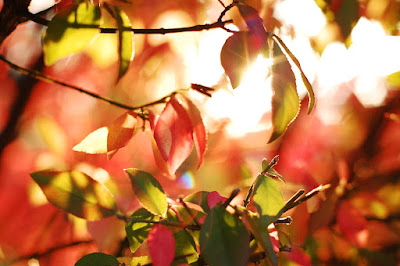This past weekend, I was able to get some pictures of my parents' firebushes. I was really just killing time, not planning anything...but it worked out fortuitously.
I've wanted to post a bit about lighting, but time and experience are both factors here.
The bushes look a bit like this:
.JPG) |
| 24mm, 1/100s @ f/4, ISO 400 |
This is actually the "pretty" version of the bushes, taken at the end of the set. With somewhat poorer lighting and bad composition, we get something eternally uglier:
 |
| 24mm, 1/320s @ f/?, ISO 400 |
This is obviously not the sort of picture you take to give your parents. I don't really excel at all with composition involving larger objects (buildings, plants, people), and so most of the time I work in close-up.
This implies a relatively short depth-of-field and a longer focal length. My 24mm gives a good field of view, but is not so useful as the 50 for isolating subjects and rendering better backgrounds. I played with both. An example of the 24 with ugly lighting:
 |
| 24mm, 1/25s @ f/?, ISO 400 |
After a little while, the sun began to set, and it illuminated the bushes brilliantly. Peeking through the bushes here, you can see the sun:
 |
| 24mm, 1/25s @ f/?, ISO 400 |
As I realized this was happening, I switched lenses and dialed up a cloudy white balance. This added a bit of orange to each of the scenes, and it improved the quality of the pictures dramatically. Unfortunately, programmed auto messed everything up:
 |
| 50mm, 1/500s @ f/11, ISO 400 |
Naturally I could have used the flash to try to illuminate the foreground, and in most cases that's probably the way to go. However, the distance from flash to subject was so small that the illumination was harsh and unnatural. This meant that I had to adjust manually—and that's just what I did. The results were pretty:
 |
| 50mm, 1/200s @ f/3.0, ISO 400 |
In each of the pictures, the sun plays a crucial role, not just in illuminating, but as a key feature:
 |
| 50mm, 1/200s @ f/3.0, ISO 400 |
The sun is a double-edged sword, though. While it provides nice golden illumination and helps turn the backgrounds into pastels, you'll see that the image appears almost doubled here. Artistically that's not much of a problem (at least for the photographer; viewers will have other opinions), insofar as it lends a bit of out of focus look.
When capturing the same with the 24mm, the field of view is widened quite a bit:
 |
| 24mm, 1/100s @ f/4, ISO 400 |
This has a negative impact on composition, which is usually better done by reducing the number of elements in the picture, not by adding them. The nice thing is that the sun's influence in the photo, while still marked, is somewhat mitigated by the increased area. (Light transmission formulae are really cool, in case you were wondering.)
Here are a couple more from the set to enjoy:
 |
| 50mm, 1/200s @ f/3.0, ISO 400 |
 |
| 50mm, 1/200s @ f/3.0, ISO 400 |
I shot these all without a filter to avoid ghosts, but I ended up getting some interesting effects from the sun anyway. I think one of the things the sun actually helped do was make the backgrounds a bit more pastel—it probably overwhelmed the sensor some and lent a somewhat more ethereal feeling to the pictures.
The whole set was over a hundred photos in size, and naturally I don't have the time to dissect them all. As time avails, I'll throw up an album with them.
No comments:
Post a Comment